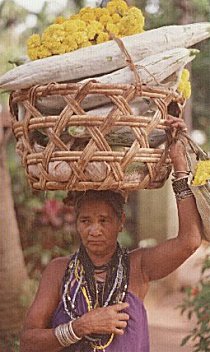Halakki Farmers of Uttara Kannada

A Gowdathi Goes to Bazaar
Halakki Vokkals are confined to the coastal talukas of Uttara Kannada
district of Karnataka. They are agriculturists living on farm lands located at the
outskirts of towns that are sandwiched between the mighty Western Ghats in the East and
the expanse of the Arabian sea an the West, 75,000 Halakkis live in Koppas under direct
control of their community heads. Mud walls and floors of their thatched huts are
elaborately decorated with "Hali" (white Rangoli against black or red
background.) "Halakki Kannada" refers to the dialect of the state language in
which these people converse. They have a rich folklore.
Their women (Gowdathis) are graceful, light in color and very pretty. The hair are parted
in the center and brought back into a pendulous bun. Their nose, ears, necks, arms and
ankles are loaded with ornaments made of brass, copper and silver. They have a great fancy
for blue, yellow and red beads, and wear them in large numbers, around their necks in the
form of strings. Women are extremely hard working and a bridegroom has to pay
"Tara" (bride price) to his father-in-law prior to wedding.
Men are of darker complexion and wear a short rumal on their heads. The old
timers do not like to wear more than a loin-cloth, but the youngsters go in for shirts.
However, men are in their true colors at the time of "Suggi Kunita" (Harvest
dance) celebrated at the time of Holi festival. Two weeks in advance they commence
practicing singing and dancing in an open space, at nights. They lavishly spend their hard
earned money on gorgeous costumes and musical instruments. On an auspicious day the
dancers gather in a community pendal and offer prayers to their deity and seek blessings
of the elders. The village head has the privilege of witnessing the dance performance
first.
The dancers costumes will put a male peacock to shame. Their turbans are decorated with
red, yellow and blue beads. An attractive "Turaayi" (head gear) is inserted in
the center of the turban. The local Gudigars prepare them from pith and
"begadi." Some of the red and yellow flowers have pith birds on them. Each
dancer wears a long kurta, red or yellow pyjama and flowing shoulder robes. They carry
"kuncha" (a bunch of peacock feathers inserted in a wooden handle and
"kolu" (playing sticks.) "Gumate" (tow faces ear--then drum one face
of which is covered by "chappa" skin,) "jagate" (beating disc,) and
"Tala" (cymbals) provide a loud background music. The dancers move in a circle
singing devotional songs. The master of the ceremonies controls their singing and rhythmic
steps. They perform a great variety of dances including "kolata" (stick dance.)
Tired troupes are honored by offering of refreshments and coins. Their landlords and
traditionally recognized persons have the good fortune of witnessing the "Suggi
Kunita" at their residences. The troupe moves from on village to another and spends
the nights at temples. After three or hour days' tour they return to their villages on
full moon day, where a hero's welcome awaits them.
See Also:
-
"Who says the poor cannot be happy ?" - Portrait of a Gowdati at Hebbar Hittal
- Alpana Ritual Art of the Halakki Tribals
- The Burden of Beads
- The Children of Soil
- Folk Musicians, the Village of Kavalakki
- Grandma Gowdati (Halakki Lady) caring for a Child
- Gumatepak (seasonal music offerings) Troupe
- Halakki Woman in front of her Habitat
- Halakki Gowda Farmer
- Halakki Tribal Couple
- Halakki Tribal Woman and her Child
- Picture of a Halakki Tribal Woman
- Pictures of Halakki Community
- A Proud Housewife of Halakki Tribe
- She is very rich in beads.
- Tribals Making Festival Headgear from Bamboos
- The Turayi Headgear of a Halakki Tribal
- A Village Woman
|
|
|
|
